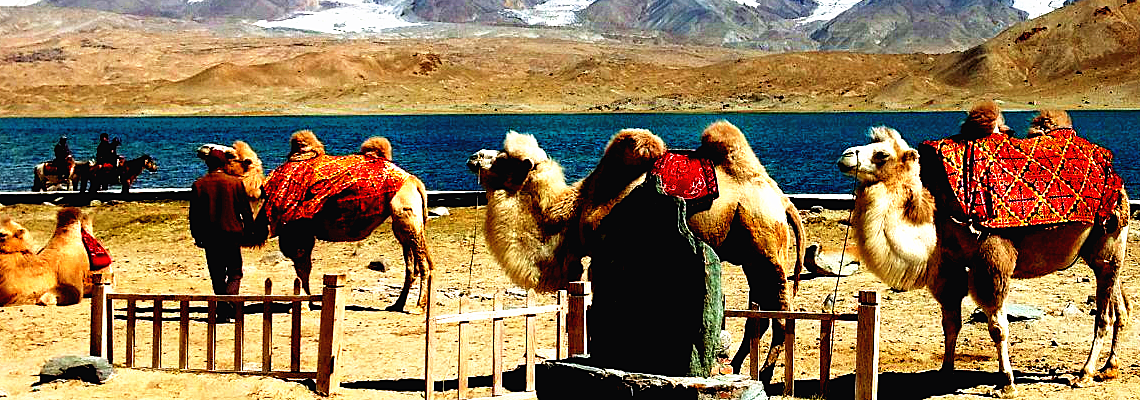
Day 1
KashgarMeet and check into hotel,rest for the free time.
Day 2
Kashgar-Karakul Lake-
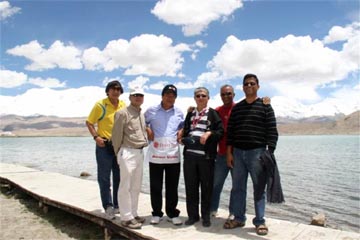
- Karakul Lake
After breakfast take the drive on the China and Pakistan highway to visit the Karakul Lake.
Karakorum high way It is 1200 kilometers almost Sino Pakistan—Chinese friendship high way build since 1976. Ancient Silk Road Merchants often run Via over Karakorum, Wahan corridor with Hindi Kush Mountain to India, Pakistan until Iran. On the road, enjoy the scenery of the Mt. Muztag, Taxkorgan, Persian language that means, stone castle.
Karakul Lake At an altitude of 3,600 m. it is the highest lake of the Pamir plateau, near the junction of the Pamir, Tianshan and Kunlun Mountain ranges. Surrounded by mountains which remain snow-covered throughout the year, the three highest peaks visible from the lake are the Muztag Ata (7546m), Kongur Tagh (7,649m) and Kongur Tiube (7,530 m). The lake is popular among travelers for its beautiful scenery and the clarity of its reflection in the water, whose color ranges from a dark green to azure and light blue. There are two Kirgiz settlements along the shore of Karakul Lake, a number of yurts about 1km east of the bus drop-off point and a village with stone houses located on the western shores
Day 3
Kashgar-
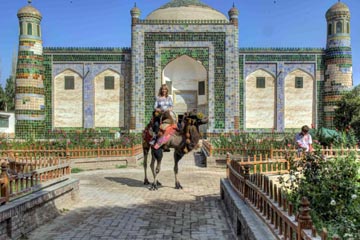
- Apak Hoja Tomb
After the breakfast take the city tour,visit the Idigar Mosque,Apak Hoja Tomb,Old Town and Handicraft street.
Id Kah Mosque is the large Mosque in China and most famous one in Xinjiang. The Mosque started to build in the mid of fifteenth century, and has gradually developed to the present size. Id K ah Mosque, with about 16800 square meters in area, consisting of Pray Hall, the Koran teaching Hall, The Corridor, the Arches and other buildings attaching to it. The Pray Hall of the mosque can hold 4000 prayers is supported by 140 carved wooden pillars.The buildings of Id Kah Mosque look magnificent and solemn, and display the artistic styles of Islamic mosque architectures.
Apak Hoja Tomb This Mazar is the holiest place in Xinjiang and an architectural treasure Built in 1640 , it is reminiscent of the Central Asian artistic style of Samarkand or Isfahan. A handsome blue-and-white tiled gate leads into the compound, which includes a small religious school and the Abakh Khoja family tomb. The latter is domed and faced with multi - colored tiles. I t most complete Islamic tomb of the Qing Dynasty up-to-now in China.
Old Town will provide a sense of what this legendary Central Asian hub was like in the days when the Silk Road was at its zenith. 500-year old remnants of the city wall, narrow lanes and colorful multi-ethnic crowds combine to make Kashgar's historic district a highlight of any visit to the city.
Day 4
Kashgar-Yarkent-

- Yarkent
After breakfast visit the Grand Sunday Bazaar,and then drive to Yarkent and Visit Yingisha Knife Factory en route.Visit Yarkent Old Town, Yarkent King and Amanishan Tomb upon arrival.
Sunday Bazaar (livestock Market)Streets near this big market are choked on Sundays with farmers and buyers arriving by donkey cart, truck, bicycle, horseback, ute, motorbike or on foot, with their animals. It's loud, lively and cheerful as they arrive, eat breakfast, set up their animals and check out the action. Cattle, sheep (they definitely look different), goats, donkeys, horses have their own sections; sellers show their animals are "good eaters"(most go as livestock not meat) and the entire experience is fascinating and fun.
Yingisha knife factory The are dozens of knife shops here(though prices are not much better than Kashgar)and its possible to visit the knife factory(xiaodaochang is Chinese)in the center of town to see the knives actually being made. Each worker makes the blade, handle and inlays himself, using only the most basic of tools
Yarkent King and Amanishan Tomb This city forms an oasis at the western end of the Taklimakan desert as a trade center. Mainly inhabited by Turkic-speaking Muslims, it has more than 120 mosques. The Uygurs are excellent at dancing. The "12 Mukams" (opera) is an epic comprising more than 340 classic songs and folk dances. After liberation, this musical treasure, which was on the verge of being lost, was collected, studied and recorded by Amannisha who is the concubine of Yarkent King.She died aged 34.
Day 5
Yarkent-Khotan-
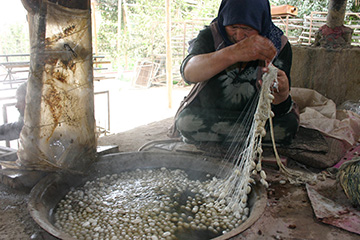
- Atlas Silk Workshop
In the morning head to Khotan,Visit Atlas Silk Workshop, Rewake Buddha Temple, Khotan Museum.
Atlas Silk Workshop is open every day and demonstrate the entire process from cocoon to weaving. Which has a showroom where you can buy Atlas silk by the meter or made into scarves, bags, dresses and other items.
The Site of Rewake Buddha Temple lies in the Julakansiman desert, 40 kilometers away from the Yulong Kashi town of Luopu county in Khotan,the national key protected cultural relic.
Khotan Museum has a floor space for exhibition of about 200 square meters. Besides wooden tablets, the main exhibition “Khotan Historical Relics Exhibition” displays potteries, wooden wares, textiles, sculptures and building components from ancient sites and tombs in Khotan area, totaling over 200 specimens. Among them the Kharosthi and Hotanese tablets, wool fabrics and various sculptures are of distinctive Khotan feature.
Day 6
Khotan -Kuqa-
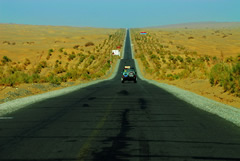
- Taklamkan Desert Highway
After breakfast head to Kuqa .Drive on the Taklamkan Desert Highway and enjoy the view of the great desert.
Taklamkan Desert Highway It is the biggest moving desert in the world and most of the people believe that it has buried most of good civilizations among the central Asia. It has occupied land more than 345,000 square km, Taklamakan in local Uyghur language means “Tha desert which buried some places under”, and after some western explorers explore this desert on the early of 20th century, they have given another meaning which is “One go, but never come back".
Day 7
Kuqa-
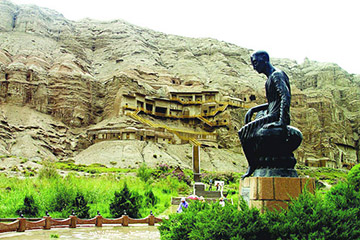
- Kizil Grottoes
After breakfast Visit Kizil Grottoes , Great Tianshan Canyou and Kuqa Bazaar.
Kizil Grottoes the caves were excavated on the cliff of Qul-tagh Mountain by the Muzart River, as the earliest caves in Xinjiang, they care also the earliest ones in China. The contents of these paintings are very rich. Including jataka stories, Buddha’s life story and the stories about karma.
Great Tianshan Canyon Known as the most stunning Canyon in China, five thousand meters in total length, and two hundred meters in average depth, the Grand Canyon was once the ancient river course for Kucha River. We will take a half an hour walk in the Grand Canyon to experience the gorgeous scenery.
Kuqa Bazaar There are wonderful, offerings of dried fruit and delicacies, clothes, shoes, leather, textiles, rugs and carpets as well as scarves, souvenirs and other goods in an eclectic mix that appeals to traveler and native alike. Open on Friday, the big day when the farmers come to town, and those who still prefer to shop at the market rather than city shops.
Day 8
Kuqa-Turpan-
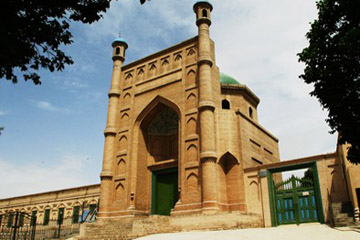
- Kuqa Grand Mosque
Drive to Turpan-the famous for the grapes, hot weather and historical sites after visit Kuqa Mosque, Subashi Ruins.
Kuqa Mosque It is located in the north of the old city of Kuqa and covers an area of 1165 square meters. With a capacity of 3000 people, it is the second largest mosque in Xinjiang, The mosque consists of a main worshiping hall, a small worshiping hall, a minaret, a qubbah, a religious court and hostels, etc. The mosque is a representative of Uygur architectural art of the Qing Dynasty.
Subashi ruins,The site is located on the ridges on both sides of Kuqa River and 23 kilometers to the north of Kuqa City . “Subashi” means “headwater of a river”. It is composed of two parts divided by the river. With a lot of ruins of stupas, temples and grottoes from the Wei and Jin Dynasties to the end of the Tang Dynasty, the site is the biggest site of Buddhist temples in Xinjiang.
Day 9
Turpan-Dunhuang-
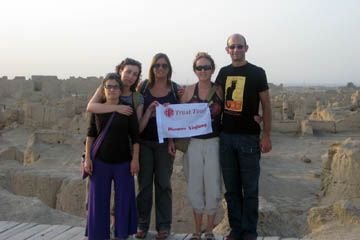
- Jiaohe Ruins
After breakfast visit Jiaohe Ruins,Karez Irrigation System and Sugong Minaret,Bezklik Grottoes,Astana Tombs.and then take the soft sleeper train to Dunhuang.
Jiaohe Ruined The Jiaohe Ruins is located on a mesa in willow leaf shape between the Yarnaz River valleys 10 kilometers to the west of Turfan City. running from northwest to southeast, 1760 meters long and 300 meters across at the widest part.
Karez Irrigation System is a unique irrigation system in Turfan, which, taking advantage of the slopes, draws the underground water to flow by itself to irrigate farmland. It consists of four parts: vertical wells, underground channels, ground canals and small reservoirs.
Sugong Minaret,Located in Mura Village 2 kilometers to the east of the city of Turpan ,the Tower was built in the 41st year of the Qianlong period of the Qing Dynasty,It is an embodiment of the ancient architectural arts of the Uygur nationality.
Bezklik Grottoes. “Bezeklik”means “a place with beautiful decoration”. These caves are first excavated in Qu`s Gaochang period. The exising caves were reconstructed by Uighurian people.
Astana Tombs are the graveyard of the residents lived in the Gaochang City in the Jin-Tang times. Between 1959 and 1975, a great number of cultural relics have been unearthed, including Chinese documents, textiles, epitaphs, coins, clay sculptures, pottery, wooden wares, silk-paintings, crops and foods ,etc., Known as “the Underground Museum.
Day 10
Dunhuang-
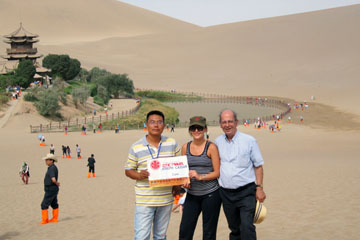
- Crescent Lake
Meet and then head to visit Mogao Grottoes , Echoing-Sand Mountain and Crescent Lake.
Mogao Grottoes:Constructed over a millennium, from the 4th to the 14th centuries, the caves hold the world's richest treasure house of Buddhist sutras, murals and sculptures.Cameras are not permitted.
Echoing-Sand Mountain: Crescent Moon Spring is 6km south of Dunhuang in the Singing Sands Mountains and is quite literally an oasis in the desert. The spring's name derives from the crescent moon shape taken by the small pool of spring water between two large sand dunes. Although the area is very dry, the pool doesn't dry up as one might expect.
Day 11
Dunhuang-
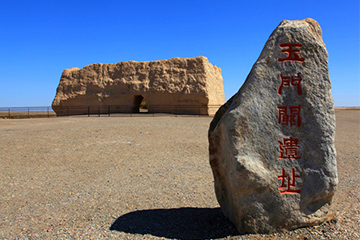
- Jade Gate Pass
After breakfast visit the Yumenguan Pass(Jade Gate Pass) .
Jade Gate Pass, or Yumenguan Pass ,was built during the Han Dynasty, by order of Emperor Wu. At the time the Pass was the only way to access the northern route of the Silk Road and the rourine connecting Central Asia and China. The vital importance of the Yumenguan Pass was realized very early in the Western Han period (205 BC-24 AD), as it was one of only two major passes along the western borders.
Day 12
Dunhuang-Your DestinationAfter breakfast check out the hotel and transfer to the airport ,take the flight to your destination.
| Departure Dates | Price Per Person | Hotel Single Supplement | Availability |
| 12th Sept | 2030usd | 450usd | available (Gauranteed) |
| 28th Sept | 2030usd | 450usd | available |
| 3rd Sept | 2030usd | 450usd | available |
Service included:
2 Personal Guide & Driver + Private car / van for Private Transfers & sightseeing
3 3 star (Luxurious) Hotels with breakfast(twin share bases) as listed in the itinerary .
4 soft sleeper train from Turpan to Dunhuang as listed in the itinerary
5 Service Charge & Government Taxes .
6 Luggage Transfers between airports and hotels
7 Goverment letter for visa support
Service excluded:
2 Personal expenses, tips to the guide and driver.
3Flights through out the itinerary

